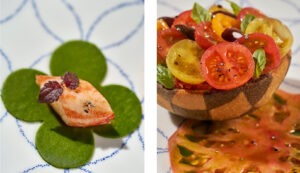
Summer in Saint-Tropez means azure coastlines, rosé-fueled afternoons, and this year — once again — culinary perfection under the Louis Vuitton banner. With the return of the Maison’s acclaimed seasonal restaurant at the White 1921 Hotel, Louis Vuitton reaffirms its growing presence in haute cuisine, welcoming back the powerhouse duo of Arnaud Donckele and Maxime Frédéric.
The Return of a Seasonal Landmark
Located at the White 1921 Hotel, a stone’s throw from Louis Vuitton’s historic store on the Place des Lices, the restaurant is more than just a pop-up. It’s a statement of lifestyle — ephemeral yet essential, anchored in French elegance and seasonal rhythm. The reopening for summer 2025 marks a refined evolution of what debuted as a brand extension and has since matured into a full-fledged culinary destination.
The Chefs: Donckele and Frédéric, Back in Sync
Arnaud Donckele is a three-Michelin-starred titan known for his mastery of sauces and symphonic layering of Provençal flavors. Maxime Frédéric, the pastry virtuoso behind some of the most refined desserts in Paris, has redefined what modern patisserie can be — intelligent, precise, emotional.
Their reunion under the Louis Vuitton Culinary Community banner is not just a nostalgic team-up. It’s a continuation of a new gastronomic chapter, one that began at Cheval Blanc Paris and now pulses through Saint-Tropez’s sun-drenched gardens.
Donckele, who helms Plénitude in Paris, brings a depth of terroir knowledge — his food is intimate yet intricate. Frédéric counters with a whisper of whimsy, crafting patisserie as art without losing soul. Together, they write a menu that reads like poetry but lands with unforgettable clarity on the palate.
Culinary Narrative: A Journey Through Flavour and Craft
Dining at Louis Vuitton Saint-Tropez isn’t just about consumption — it’s about narrative. Each course builds a story. Seasonal ingredients are not just highlighted; they’re framed, exalted, contextualized.
Starters might feature tomatoes grown in the Var region, compressed and clarified into a translucent consommé poured tableside over burrata and basil oil spheres. It’s a familiar dish turned inside out — both nostalgic and futuristic.
Main courses venture into deeper territory: Mediterranean line-caught fish in a saffron shellfish emulsion that pays homage to bouillabaisse, or lamb from Alpilles slow-roasted and finished with a jus perfumed with myrtle.
And then there’s dessert — Frédéric’s canvas. A mille-feuille layered with tonka cream and almond praline arrives encased in a spun sugar sculpture reminiscent of Vuitton’s monogram pattern. It’s the finale guests remember days later — flavor grounded in childhood memories, delivered with architectural elegance.
Tableware as a Statement: Vuitton on the Plate
It wouldn’t be Louis Vuitton without design — and this year’s dining experience introduces the brand’s latest tableware collection. This isn’t a backdrop. It’s integral to the meal.
Porcelain dishes draw from the Maison’s archival motifs, while flatware subtly echoes trunk clasps. Napkins carry fine-stitched edgework inspired by Vuitton’s leather goods. The centerpiece? A sculpted breadbasket in Monogram-embossed leather, made in the same Asnières workshops that produce the brand’s bespoke trunks.
In an industry where tableware often fades into the background, Vuitton brings it forward — as an aesthetic and tactile extension of the dining experience. Function becomes fashion. Utility becomes identity.
Design of the Space: Where Summer Breathes
The White 1921 Hotel is transformed again into a tranquil oasis of sand-hued palettes, soft linen canopies, and custom Louis Vuitton furnishings. This year’s interior redesign features subtle nods to Riviera modernism — teak furniture with brass inlays, sea-washed ceramics, and an open kitchen that dissolves the boundary between performance and preparation.
Outdoor tables stretch beneath lemon trees and climbing jasmine. Ambient music is curated to mirror the pacing of the menu: light and airy at lunch, deeper and more sensual by dinner. The result is immersive but never over-designed — the luxury of space, time, and attention.
The Message: What Louis Vuitton Is Really Saying
This isn’t about selling handbags with dessert. Louis Vuitton’s restaurant is not a gimmick or a marketing detour — it’s a strategy of brand expansion through lived luxury.
By stepping into fine dining, Vuitton moves into the daily rituals of its clients. It’s no longer just about what you wear — but how you eat, where you gather, and what sensory memories you create. These experiences deepen the Maison’s relationship with customers beyond retail.
It’s also a way of future-proofing. As fashion shifts toward quiet luxury and experiential value, high-end brands need more than logos — they need environments. Context. Feeling. Vuitton gets that.
The Cultural Shift: Fashion x Food
Louis Vuitton isn’t the first luxury house to dabble in food. Gucci Osteria, Prada’s Bar Luce, and Dior Café have all tested the waters. But Vuitton has gone further — treating its culinary ventures not as auxiliary, but as essential. The Vuitton restaurants in Saint-Tropez, Seoul, and Tokyo operate with serious culinary leadership and vision.
The Maison’s Culinary Community — a growing network of chefs, artisans, and collaborators — suggests deeper investment. It’s not about celebrity endorsements or surface-level pop-ups. It’s about craftsmanship, storytelling, and permanence.
In a way, this mirrors the evolution of haute couture: moving from spectacle to substance.
Guest Experience: More Than a Meal
Reservations are by design exclusive, but the tone is not. Staff are trained in both Michelin service and Louis Vuitton hospitality — attentive but warm, precise but human. Guests are greeted not as patrons, but as participants.
Menus are printed on textured stock with foil detailing. Courses are introduced with quiet confidence, and dishes come with suggested non-alcoholic pairings featuring custom Louis Vuitton elixirs (a mix of regional botanicals and teas developed in collaboration with herbalists).
There’s no hard sell, no product placement. Just a deeply branded environment — one where food, design, and emotion all flow in sync.
What’s Next: A Taste of Expansion
Though the Saint-Tropez restaurant remains seasonal, insiders suggest Louis Vuitton may explore a permanent flagship restaurant in Paris by 2026 — a project that could tie in with its Champs-Élysées expansion and cultural programming.
Donckele and Frédéric are expected to remain central to this vision, potentially mentoring new chefs in the Vuitton ecosystem. Expect more collaborations with artisan producers, perfumers, and even vintners — folding all sensory domains into the culinary experience.
In other words: Louis Vuitton is building a lifestyle, one plate at a time.
Final Course: Why This Matters
Louis Vuitton’s return to Saint-Tropez isn’t just about food. It’s about slowing down. Taking a long lunch under the shade of citrus trees. Remembering that luxury isn’t about having — it’s about feeling. About memory. About the experience of time well spent.
With Donckele and Frédéric back at the helm, the Maison delivers something few brands can — true immersion. Not branded content. Not influencer gloss. But real, considered hospitality.
In Saint-Tropez, Louis Vuitton has created something ephemeral yet unforgettable. Like a perfect summer day. And this year, the table is set once again.
No comments yet.









